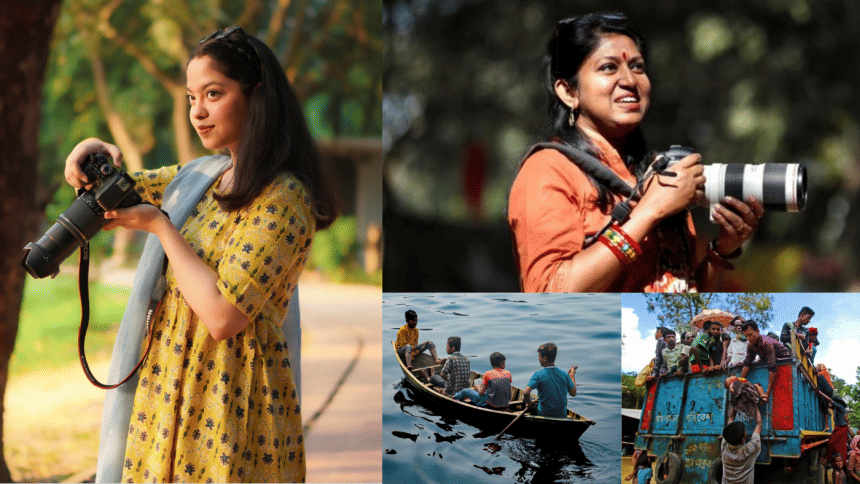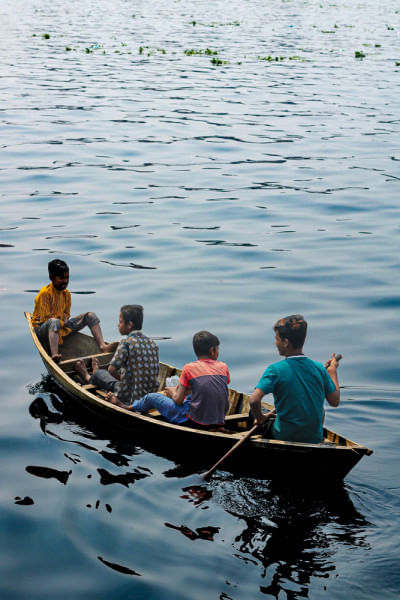Photography, regardless of gender, is a tough profession. In the photo: Naila Noor (left), Sabina Yesmin (right). Photos: Naila Noor (left), Sabina Yesmin (right)
“>
Photography, regardless of gender, is a tough profession. In the photo: Naila Noor (left), Sabina Yesmin (right). Photos: Naila Noor (left), Sabina Yesmin (right)
Photography is at the core of our modern lives. It is well embedded in our daily activities through news, memories and content. However, the gender gap in this accelerating profession is truly staggering. Women are often sought on the opposite side of the camera. How is it that in a country outnumbered by women (according to the census 2022), we consume content largely from a male perspective? While many may argue there is a lesser percentage of women in the sector due to the profession’s demanding nature, there are also other aspects that restrict a woman’s participation and contribution in the world of professional photography.
Photo: Fabeha Monir
“>
Photo: Fabeha Monir
Before everything else – photography is a very hard profession. “Being in the field, waking up in different locations is a different experience for any woman photographer,” says photojournalist, filmmaker and documentary photographer Fabeha Monir. Even though both men and women photographers have trouble navigating these struggles, women have an extra burden of societal and familial expectations. It is not easy for young female photographers to negotiate these issues of time and traveling with their families.
Photo: Naila Noor
“>
Photo: Naila Noor
“My family members and friends often try to dissuade me from going to certain places for my shoots due to safety reasons,” says freelance photographer Naila Noor. Even though these concerns are legitimate, when you see it from their perspective, it is a setback in terms of productivity and work. While going to shoot in different outdoor locations, women photographers have to plan their attitude and equipment accordingly. Naila laments that a male photographer doesn’t have to go through this extra hassle. While it may seem like these are small adjustments to be made, it can take a toll on the person facing it constantly.
In terms of work assignments, women are often singled out with assignments that don’t require much ‘trouble’ for the employer. When Sabina Yesmin started her work as a photojournalist in Prothom Alo, she was often given only cultural assignments or women-children-related issues. But, with time, as she proved herself, she started covering leads. In a career spanning over 12 years, Sabina Yesmin covered many important issues including natural disasters and protests in our country. Her photographs are widely distributed and recognized, even in a world where men are currently dominating.
Photo: Sabina Yesmin
“>
Photo: Sabina Yesmin
“It is difficult for a woman to separate her personal and professional life. Whenever a woman comes to work in this field, they fight and challenge the familial and social expectations set upon them,” says Sabina. According to her, photography, particularly photojournalism, is still not seen as a viable career for women. On top, the constant discriminatory and sexist behavior at work often affects their mental health. Sabina adds that women often quit this field on their own, unable to deal with these constant challenges along with social and familial pressures.
The topic of salary or remuneration continues to be one of the biggest issues for female photographers. As they are given low-priority assignments, they tend to get paid less. Even in the case of freelance or independent work, female photographers are paid less. Many clients even (only) go with a female photographer when their budget is low. Moreover, there is a lack of precedent as the number of female photographers is less. Many leading media houses and newspapers in our country still don’t have female photographers or photojournalists.
The matter of security and surroundings transcends the work of a female photographer in every possible scenario. Men can go into the unknown and click on their stories without having to worry about safety. However, women aren’t so lucky in that regard. Moreover, people in our country don’t normally respond well to a female photographer taking pictures. “During my outdoor shoots, I have been subjected to rude comments and stares by a passerby,” says Fouzia Jahan, owner of the local cinematography and visual styling brand Bower Dighi. Moreover, there are certain stereotypes about women not being adept at technical details or messing up big responsibilities that overshadow a female photographer – adds Fouzia.
Photo: Fouzia Jahan
“>
Photo: Fouzia Jahan
When Naila Noor started her product photography brand, Aalo Productions, she saw the labels of a female photographer automatically attached to her brand. “Potential clients often doubt if I am capable of giving them what they want based on my gender,” adds Naila. This constant discrimination and sexist behavior often demoralizes female photographers. There is nothing more heartbreaking than getting dismissed without having a chance in first place.
If you’re a female photographer, one of the major realizations that hit you is the underrepresentation of female photographers in the industry. Even though active female photographers have won international recognition, they often don’t find their due place in the digital space. A recent article covered in a major newspaper about the current booming state of the photography industry in Bangladesh failed to include even one female photographer on the list. Makes you wonder!
However, rising above, female photographers are taking their moments of glory. Fouzia credits the rise of female entrepreneurship as a turning point for female photographers in our country. Even though discriminations and behaviors keep happening, Fabeha believes we need to focus on the art and the passion that we brought here. In the end, we have to let our work speak for ourselves.
She further adds that photographers need to look at things like art, literature, printmaking, design and illustration. “This way, they can broaden their perspective in regard to what is being done in the greater creative world,” she comments. All the photographers mentioned above believe young budding photographers should invest in courses and degrees related to their field of choice. There are schools and universities in our country offering great photography courses. Fabeha suggests photographers work under a mentor. This gives them a perspective and experience of working as a photographer.
There are some glimmers of sunshine amidst all this darkness. Many clients prefer female photographers to suit their work. Fouzia believes women are more adept at the concept of development. This gives them an edge over their colleagues. Even though these instances are few, they are still there. The goal is to add more diversity to mainstream photography.
Sabina added, “Photographs don’t see gender; we, the people, separate the art through these.” Female photographers are actively doing great work. The number has risen significantly in the past decade. Even though the discrimination, the setbacks are still there, female photographers need to work towards their passion and work it to their advantage. Sabina added that female photographers need to be patient and fearless to persist in this career.
With that, I am ending the article by manifesting a future where women photographers take their wins and capture their ceiling without any barriers and bias.



 For all the latest news, follow The Daily Star’s Google News channel.
For all the latest news, follow The Daily Star’s Google News channel.

